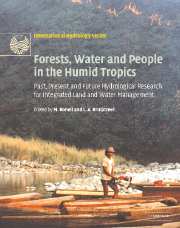 Forests, Water and People in the Humid Tropics
Forests, Water and People in the Humid Tropics Book contents
- Frontmatter
- Contents
- List of contributors
- Foreword
- Preface
- Acknowledgements
- Symposium and Workshop
- Introduction
- Part I Current trends and perspectives on people–land use–water issues
- Part II Hydrological processes in undisturbed forests
- 10 An overview of the meteorology and climatology of the humid tropics
- 11 Synoptic and mesoscale rain producing systems in the humid tropics
- 12 Climatic variability in the tropics
- 13 Controls on evaporation in lowland tropical rainforest
- 14 Runoff generation in tropical forests
- 15 Erosion and sediment yield in the humid tropics
- 16 Rainforest mineral nutrition: the ‘black box’ and a glimpse inside it
- 17 Hydrology of tropical wetland forests: recent research results from Sarawak peatswamps
- 18 Tropical montane cloud forest: a unique hydrological case
- Part III Forest disturbance, conversion and recovery
- Part IV New methods for evaluating effects of land-use change
- Part V Critical appraisals of best management practices
- Conclusion: Forests, water and people in the humid tropics: an emerging view
- Plate section
- References
17 - Hydrology of tropical wetland forests: recent research results from Sarawak peatswamps
from Part II - Hydrological processes in undisturbed forests
Published online by Cambridge University Press: 12 January 2010
- Frontmatter
- Contents
- List of contributors
- Foreword
- Preface
- Acknowledgements
- Symposium and Workshop
- Introduction
- Part I Current trends and perspectives on people–land use–water issues
- Part II Hydrological processes in undisturbed forests
- 10 An overview of the meteorology and climatology of the humid tropics
- 11 Synoptic and mesoscale rain producing systems in the humid tropics
- 12 Climatic variability in the tropics
- 13 Controls on evaporation in lowland tropical rainforest
- 14 Runoff generation in tropical forests
- 15 Erosion and sediment yield in the humid tropics
- 16 Rainforest mineral nutrition: the ‘black box’ and a glimpse inside it
- 17 Hydrology of tropical wetland forests: recent research results from Sarawak peatswamps
- 18 Tropical montane cloud forest: a unique hydrological case
- Part III Forest disturbance, conversion and recovery
- Part IV New methods for evaluating effects of land-use change
- Part V Critical appraisals of best management practices
- Conclusion: Forests, water and people in the humid tropics: an emerging view
- Plate section
- References
Summary
INTRODUCTION
Freshwater wetlands are distributed widely throughout the tropical areas of Africa (340 000 km2; Pajunen, 1996) and South America (430 000 km2; Lappailanen and Zurek, 1996). Many of these wetlands are covered with forest (Lugo et al., 1990). However, South East Asia has more wetland forest than any other part of the world: here, huge expanses of so-called ‘peatswamp’ forest can be found – often in association with other wetland forest types such as sago, melaleuca, nipah palm and mangrove. In Indonesia alone, the original extent of peatswamp forest exceeded 200 000 km2 (Rieley et al., 1996), while Malaysia had 25 000 km2 (Ambak and Chye, 1996). Significant peatland areas also exist in other Asian countries. In fact, the total wetland area of Asia as a whole is estimated at no less than 2 268 000 km2, of which 1 119 000 km2 is peatland (including non-forested and non-tropical peatlands; Lappailanen, 1996). In contrast, the peatland area in Africa and South America is estimated at only 58 000 and 102 000 km2, respectively. There is a significant expanse of wetland forest in the southern parts of the United States too but only some 10% of this is peatland (Malterer, 1996).
The peatswamps of South East Asia, with peat deposits frequently over 3 metres deep and often covered with lush rainforest, could be considered as the most ‘typical’ type of tropical wetland forest because here ecological functioning and wetland hydrology are truly interdependent (Page et al., 1999) (Box 17.1).
- Type
- Chapter
- Information
- Forests, Water and People in the Humid TropicsPast, Present and Future Hydrological Research for Integrated Land and Water Management, pp. 447 - 461Publisher: Cambridge University PressPrint publication year: 2005
References
- 13
- Cited by


